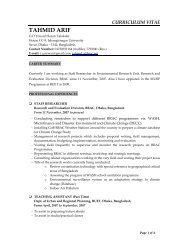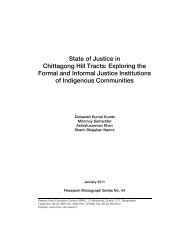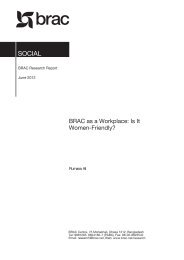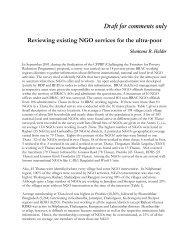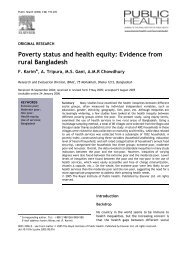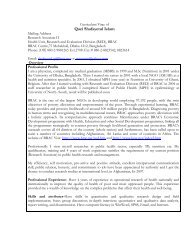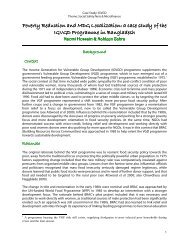Combining health and social protection measures to reach the ultra ...
Combining health and social protection measures to reach the ultra ...
Combining health and social protection measures to reach the ultra ...
Create successful ePaper yourself
Turn your PDF publications into a flip-book with our unique Google optimized e-Paper software.
Access <strong>to</strong> <strong>health</strong><br />
2001, WTO ruled that <strong>the</strong> French ban on <strong>the</strong> import of all<br />
products containing asbes<strong>to</strong>s was legal on <strong>health</strong> grounds,<br />
despite protests from Canada 15,16 . However, protecting citizens<br />
against <strong>health</strong> risks in cases of scientific uncertainty is still<br />
difficult, as WTO is reluctant <strong>to</strong> accept precautionary trade<br />
restrictions 17 .<br />
Economic development<br />
Opinions differ with regard <strong>to</strong> <strong>the</strong> economic benefits of<br />
economic globalization. On one side, “optimists” argue that<br />
global markets facilitate economic growth <strong>and</strong> economic<br />
security, which would benefit <strong>health</strong> (e.g. Frankel 18 , Ben<br />
David 19 , Dollar <strong>and</strong> Kraay 20 <strong>and</strong> Feachem 21 ). On <strong>the</strong> o<strong>the</strong>r<br />
side, “pessimists” are worried about <strong>the</strong> <strong>health</strong> effects of <strong>the</strong><br />
global market. Baum 22 states that “<strong>the</strong> current forms of<br />
globalization are making <strong>the</strong> world a safe place for unfettered<br />
market liberalism <strong>and</strong> <strong>the</strong> consequent growth of<br />
inequities…posing severe threats <strong>to</strong> people’s <strong>health</strong>”. The<br />
2005 Human Development Report 23 argues that one of <strong>the</strong><br />
prevailing “myths” of economic globalization is that open<br />
markets will result in an era of convergence; trade<br />
liberalization “has done little <strong>to</strong> slow down <strong>the</strong><br />
marginalization of sub-Saharan Africa” <strong>and</strong> <strong>the</strong> current<br />
“trading system favours <strong>the</strong> developed world”. In fact,<br />
notwithst<strong>and</strong>ing some spectacular growth rates, especially in<br />
East Asia, incomes declined between 1965 <strong>and</strong> 1997 in 16<br />
of <strong>the</strong> world poorest countries 24 .<br />
Trade<br />
Due <strong>to</strong> <strong>the</strong> establishment of global markets <strong>and</strong> a global<br />
trading system, <strong>the</strong>re has been a continuing increase in world<br />
trade. According <strong>to</strong> <strong>the</strong> WTO, <strong>to</strong>tal trade multiplied by a fac<strong>to</strong>r<br />
of 14 between 1950 <strong>and</strong> 1997 25 . More recently, <strong>the</strong> year<br />
2004 saw an impressive growth in trade, which exceeded<br />
average growth recorded over <strong>the</strong> preceding decade 26 . Today<br />
all countries trade internationally <strong>and</strong> <strong>the</strong>y trade significant<br />
proportions of <strong>the</strong>ir national income. The array of products<br />
being traded is wide-ranging; from primary commodities <strong>to</strong><br />
manufactured goods. Besides goods, services are increasingly<br />
being traded as well 27 . In addition <strong>to</strong> legal trade transactions,<br />
illegal drug trade is also globalizing.<br />
Social interactions: migration<br />
Due <strong>to</strong> <strong>the</strong> changes in <strong>the</strong> infrastructures of transportation <strong>and</strong><br />
communication, human migration has increased at<br />
unprecedented rates. According <strong>to</strong> Held et al. 27 , <strong>to</strong>urism is one<br />
of <strong>the</strong> most obvious forms of cultural globalization. However,<br />
travel for business <strong>and</strong> pleasure constitutes only a fraction of<br />
<strong>to</strong>tal human movement. O<strong>the</strong>r examples of people migrating are<br />
missionaries, merchant marines, students, pilgrims, militaries,<br />
migrant workers <strong>and</strong> Peace Corps workers 27,28 . Besides <strong>the</strong>se<br />
forms of voluntary migration, resettlement by refugees is also an<br />
important issue. The UN Population Division estimates <strong>the</strong><br />
global migrant population in 2005 at between 185 <strong>and</strong> 192<br />
million people 29 . However, <strong>the</strong> concerns regarding <strong>the</strong><br />
economic, political, <strong>social</strong> <strong>and</strong> environmental consequences of<br />
migration are growing 30 <strong>and</strong> many governments are moving<br />
<strong>to</strong>wards more restrictive immigration policies.<br />
Social interactions: conflicts<br />
In <strong>the</strong> aftermath of <strong>the</strong> terrorist attacks on September 11<br />
2001, many questioned <strong>the</strong> possible links between<br />
globalization <strong>and</strong> <strong>the</strong> risk on conflicts. On <strong>the</strong> one side,<br />
globalizations can decrease <strong>the</strong> risk on tensions <strong>and</strong><br />
conflicts, as societies become more dependent on each.<br />
O<strong>the</strong>rs argue that <strong>the</strong> resistance <strong>to</strong> globalization has resulted<br />
in religious fundamentalism, <strong>and</strong> worldwide tensions <strong>and</strong><br />
in<strong>to</strong>lerance 31 . According <strong>to</strong> Hunting<strong>to</strong>n 32 , <strong>the</strong> increasing<br />
cross-cultural interactions will result in a “clash of<br />
civilizations”. Nassar 33 describes globalization as a process<br />
that leads <strong>to</strong> a “migration of dreams” in which <strong>the</strong> world’s<br />
poor are able <strong>to</strong> learn of <strong>the</strong> luxuries of <strong>the</strong> western world;<br />
<strong>the</strong> increased degree of relative deprivation results in growing<br />
tensions. In addition, Zwi et al. 34 identify several o<strong>the</strong>r fac<strong>to</strong>rs<br />
that are associated with both globalization <strong>and</strong> <strong>the</strong> risk of<br />
conflicts, such as increased global trade in arms <strong>and</strong><br />
inadequate policies.<br />
Social interactions: <strong>social</strong> equity <strong>and</strong> <strong>social</strong> networks<br />
Global communication, global mobility <strong>and</strong> cross-cultural<br />
interaction can also influence cultural norms <strong>and</strong> values<br />
about <strong>social</strong> solidarity <strong>and</strong> <strong>social</strong> equity. It is feared that <strong>the</strong><br />
self-interested individualism of <strong>the</strong> marketplace spills over<br />
in<strong>to</strong> cultural norms <strong>and</strong> values resulting in increasing <strong>social</strong><br />
exclusion <strong>and</strong> <strong>social</strong> inequity. Exclusion involves<br />
disintegration from common cultural processes, lack of<br />
participation in <strong>social</strong> activities, alienation from decisionmaking<br />
<strong>and</strong> civic participation <strong>and</strong> barriers <strong>to</strong> employment<br />
<strong>and</strong> material sources 35 . On <strong>the</strong> o<strong>the</strong>r h<strong>and</strong>, however, <strong>the</strong><br />
geographical scale of <strong>social</strong> networks is increasing due <strong>to</strong><br />
global communications <strong>and</strong> global media. Like-minded<br />
people are now able <strong>to</strong> interact at distance through, for<br />
example, <strong>the</strong> Internet. The women’s movement, <strong>the</strong> peace<br />
movement, organized religion <strong>and</strong> <strong>the</strong> environmental<br />
movement are good examples of transnational networks 27 .<br />
The digital divide between poor <strong>and</strong> rich, however, can result<br />
in <strong>social</strong> exclusion from <strong>the</strong> global civil society.<br />
Knowledge<br />
The knowledge capital within a population is increasingly<br />
affected by global developments in communication <strong>and</strong><br />
mobility. The term “globalization of education” suggests<br />
getting education in<strong>to</strong> every nook <strong>and</strong> cranny of <strong>the</strong> globe.<br />
Millions of people now acquire part of <strong>the</strong>ir knowledge from<br />
transworld textbooks. Most universities work <strong>to</strong>ge<strong>the</strong>r with<br />
academics from different countries, students have ample<br />
opportunities <strong>to</strong> study abroad <strong>and</strong> “virtual campuses” have<br />
been developed. In addition, television, film <strong>and</strong> computer<br />
graphics have greatly enlarged <strong>the</strong> visual dimensions of<br />
communication. Many people <strong>to</strong>day “read” <strong>the</strong> globalized<br />
world without a book 36 . Overall, it is expected that <strong>the</strong>se<br />
developments will also improve <strong>health</strong> training <strong>and</strong> <strong>health</strong><br />
education (e.g. Feachem 21 <strong>and</strong> Lee 37 ).<br />
Ecosystem goods <strong>and</strong> services<br />
Global environmental changes are affecting <strong>the</strong> provision of<br />
ecosystem goods <strong>and</strong> services <strong>to</strong> mankind. The<br />
Global Forum Update on Research for Health Volume 4 ✜ 069




